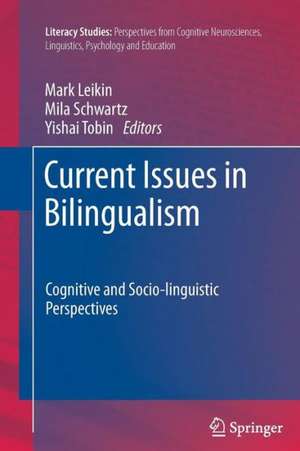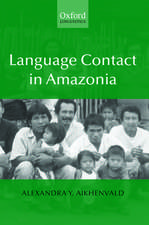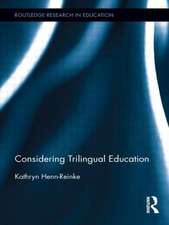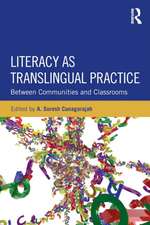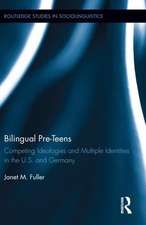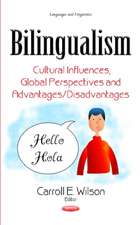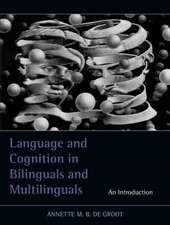Current Issues in Bilingualism: Cognitive and Socio-linguistic Perspectives: Literacy Studies, cartea 5
Editat de Mark Leikin, Mila Schwartz, Yishai Tobinen Limba Engleză Paperback – 26 ian 2014
Presenting research on bi- and trilingualism in Israel from a multitude of perspectives, the book focuses on four aspects of multilingualism and literacy in Israel: Arabic-Hebrew bilingual education and Arabic literacy development; second-language Hebrew literacy among immigrant children; literacy in English as a second/third language; and adult bilingualism. Chapters dissect findings on immigrant youth education, language impairment in bilinguals, and neurocognitive features of bilingual language processing. Reflecting current trends, this volume integrates linguistics, sociology, education, cognitive science,and neuroscience.
| Toate formatele și edițiile | Preț | Express |
|---|---|---|
| Paperback (1) | 639.41 lei 6-8 săpt. | |
| SPRINGER NETHERLANDS – 26 ian 2014 | 639.41 lei 6-8 săpt. | |
| Hardback (1) | 645.60 lei 6-8 săpt. | |
| SPRINGER NETHERLANDS – 23 noi 2011 | 645.60 lei 6-8 săpt. |
Din seria Literacy Studies
- 18%
 Preț: 955.25 lei
Preț: 955.25 lei - 18%
 Preț: 968.65 lei
Preț: 968.65 lei - 15%
 Preț: 645.47 lei
Preț: 645.47 lei - 5%
 Preț: 1100.85 lei
Preț: 1100.85 lei - 18%
 Preț: 886.40 lei
Preț: 886.40 lei - 15%
 Preț: 651.02 lei
Preț: 651.02 lei - 15%
 Preț: 640.88 lei
Preț: 640.88 lei - 18%
 Preț: 786.84 lei
Preț: 786.84 lei - 18%
 Preț: 954.45 lei
Preț: 954.45 lei - 15%
 Preț: 701.72 lei
Preț: 701.72 lei - 24%
 Preț: 802.76 lei
Preț: 802.76 lei - 15%
 Preț: 651.84 lei
Preț: 651.84 lei - 18%
 Preț: 890.68 lei
Preț: 890.68 lei - 18%
 Preț: 946.41 lei
Preț: 946.41 lei - 15%
 Preț: 638.57 lei
Preț: 638.57 lei - 18%
 Preț: 944.36 lei
Preț: 944.36 lei -
 Preț: 427.49 lei
Preț: 427.49 lei - 20%
 Preț: 620.46 lei
Preț: 620.46 lei - 18%
 Preț: 905.06 lei
Preț: 905.06 lei - 15%
 Preț: 635.65 lei
Preț: 635.65 lei - 20%
 Preț: 564.52 lei
Preț: 564.52 lei - 15%
 Preț: 637.93 lei
Preț: 637.93 lei - 15%
 Preț: 654.12 lei
Preț: 654.12 lei
Preț: 639.41 lei
Preț vechi: 752.24 lei
-15% Nou
Puncte Express: 959
Preț estimativ în valută:
122.36€ • 130.84$ • 102.01£
122.36€ • 130.84$ • 102.01£
Carte tipărită la comandă
Livrare economică 18 aprilie-02 mai
Preluare comenzi: 021 569.72.76
Specificații
ISBN-13: 9789400799288
ISBN-10: 9400799284
Pagini: 276
Ilustrații: X, 266 p.
Dimensiuni: 155 x 235 x 14 mm
Greutate: 0.39 kg
Ediția:2012
Editura: SPRINGER NETHERLANDS
Colecția Springer
Seria Literacy Studies
Locul publicării:Dordrecht, Netherlands
ISBN-10: 9400799284
Pagini: 276
Ilustrații: X, 266 p.
Dimensiuni: 155 x 235 x 14 mm
Greutate: 0.39 kg
Ediția:2012
Editura: SPRINGER NETHERLANDS
Colecția Springer
Seria Literacy Studies
Locul publicării:Dordrecht, Netherlands
Public țintă
ResearchCuprins
Introduction .- Part I. Language and Literacy in Multilingual Society. Chapter 1. Relevance of the Linguistic Coding Difference Hypothesis to English as an Additional Language of Literacy in Israel . Chapter 2. Literacy Reflexes of Arabic Diglossia . Chapter 3. Multilingualism Among Israeli Arabs, and the Neuropsychology of Reading in Different Languages .- Part II. Academic Achievement of Children Coming from Immigrant Families. Chapter 4. Cognitive, Language, and Literacy Development in Socio-Culturally Vulnerable School Children . Chapter 5. Second Generation Immigrants . Chapter 6. Understanding Language Achievement of Immigrants in Schools .- Part III. Multilingual Acquisition and Processing. Chapter 7. Adjective Inflection in Hebrew . Chapter 8. Verb Inflections Indicators of Bilingual SLI . Chapter 9. Procedural and Declarative Memory in the Acquisition of Morphological Knowledge . Chapter 10. Reading L1 and L2: Behavioral and Electrophysiological Evidence . Chapter 11. Identification of Grammatical Functions in Two Languages.
Textul de pe ultima copertă
As populations become more mobile, so interest grows in bi- and multilingualism, particularly in the context of education. This volume focuses on the singular situation in Israel, whose complex multiculturalism has Hebrew and Arabic as official languages, English as an academic and political language, and tongues such as Russian and Amharic spoken by immigrants.
Presenting research on bi- and trilingualism in Israel from a multitude of perspectives, the book focuses on four aspects of multilingualism and literacy in Israel: Arabic-Hebrew bilingual education and Arabic literacy development; second-language Hebrew literacy among immigrant children; literacy in English as a second/third language; and adult bilingualism. Chapters dissect findings on immigrant youth education, language impairment in bilinguals, and neurocognitive features of bilingual language processing. Reflecting current trends, this volume integrates linguistics, sociology, education, cognitive science,and neuroscience.
Presenting research on bi- and trilingualism in Israel from a multitude of perspectives, the book focuses on four aspects of multilingualism and literacy in Israel: Arabic-Hebrew bilingual education and Arabic literacy development; second-language Hebrew literacy among immigrant children; literacy in English as a second/third language; and adult bilingualism. Chapters dissect findings on immigrant youth education, language impairment in bilinguals, and neurocognitive features of bilingual language processing. Reflecting current trends, this volume integrates linguistics, sociology, education, cognitive science,and neuroscience.
Caracteristici
Features a multi-dimensional approach toward bilingualism issuer (linguistic/psycholinguistic, socio-linguistic, and neurocognitive approaches) Includes investigation of spoken and written bilingualism Unique focus on biliteracy, tri-literacy and diglossia
